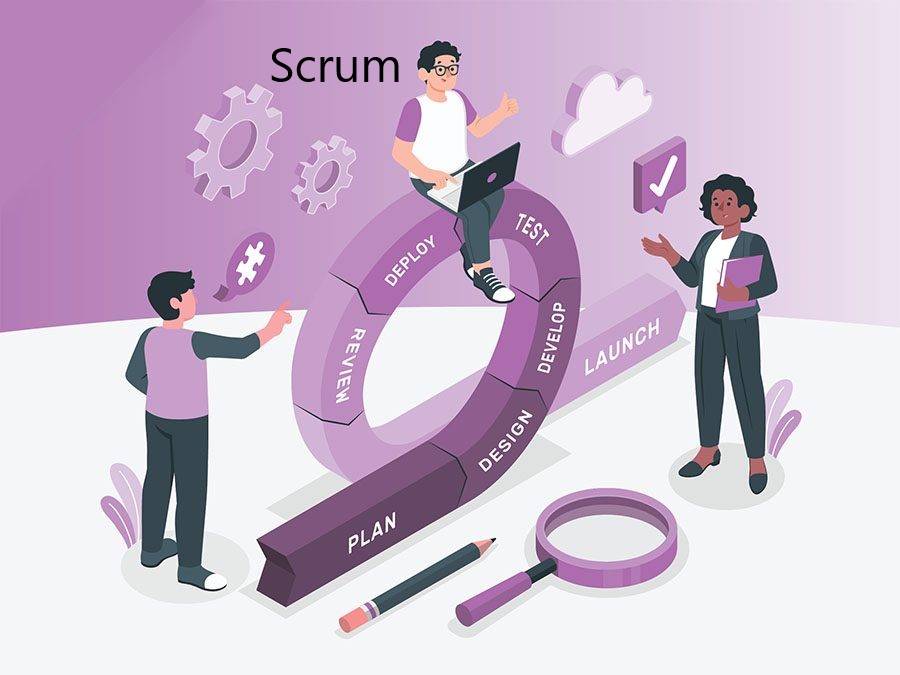
What is Scrum? An Overview of the Framework
Scrum helps teams work more efficiently, manage complexity, and deliver high-quality products incrementally through its agile methodology. It promotes collaboration, transparency, and iterative progress through short development cycles called sprints.
Scrum structures the process around several key components. One of the most important is the sprint, which typically lasts between one to four weeks. During a sprint, the team works on a defined set of tasks aimed at delivering a usable product increment by the end. Key roles in Scrum include the Product Owner, Scrum Master, and Development Team. The Product Owner is responsible for defining the project vision, managing the backlog, and prioritizing tasks based on business value. The Scrum Master serves as a facilitator. He ensures the team follows Scrum practices and removes any obstacles that could impede progress. The Development Team focuses on executing the work necessary to achieve the sprint goals.
Scrum also includes several ceremonies that promote communication and progress tracking. During Sprint Planning, the team decides what work they will complete during the sprint. The Daily Standup is a brief meeting where team members update each other on their progress and address any challenges. At the end of each sprint, the team holds a Sprint Review to showcase completed work. They then conduct a Retrospective to reflect on what went well and identify areas for improvement. This cyclical process fosters continuous feedback, allowing teams to adapt quickly and deliver value. As a result, Scrum suits projects that require flexibility and rapid iteration for success.
Key Roles in Scrum: Understanding Responsibilities
In Scrum, three key roles contribute to project success: the Scrum Master, Product Owner, and Development Team. Each role has specific responsibilities that ensure the team remains focused, aligned, and productive. These roles foster collaboration and empower teams to work efficiently within the Scrum framework.
The Scrum Master serves as a facilitator and coach, ensuring that the team adheres to Scrum practices. Their main responsibility is to remove any obstacles that could prevent the team from meeting its goals. The Scrum Master also promotes open communication within the team and shields the team from external distractions. By guiding the team through Scrum processes and encouraging continuous improvement, the Scrum Master helps maintain momentum and productivity throughout the project.
The Product Owner is responsible for managing the product backlog. This is a prioritized list of tasks and features that the team must complete. They act as the liaison between stakeholders and the development team, ensuring that the team works on the highest-value tasks. The Product Owner clearly defines the project vision and goals. He also prioritizes work based on business needs, and ensures the team understands the objectives for each sprint. Their ability to balance stakeholder needs and team capabilities is crucial to delivering value incrementally.
Professionals with the necessary skills make up the Development Team, turning backlog items into a usable product increment. This team is self-organizing, meaning they decide how to approach and complete their work without direct supervision. Collaboration is vital, as team members must work together to meet sprint goals while maintaining a high standard of quality. By working closely with both the Scrum Master and Product Owner, the Development Team ensures that the project progresses efficiently and effectively.
The Scrum Process: How Sprints Drive Project Success
The Scrum process revolves around sprints, which are short, time-boxed development cycles that help teams focus on delivering incremental value. Sprints typically last one to four weeks, and during this period, the team works on a specific set of tasks chosen from the product backlog. This cyclical approach keeps projects organized, ensuring that teams remain focused on achievable goals while continuously progressing toward the larger project objectives.
The team begins each sprint with sprint planning, collaborating with the Product Owner to define what they will accomplish. The team selects high-priority tasks from the product backlog and estimates the work required. This process aligns everyone on the sprint’s goals and ensures they understand the scope of work. Daily standups, also known as daily scrums, are brief meetings where team members provide updates on their progress, discuss any challenges, and outline what they plan to work on next. These meetings keep the team synchronized, enabling quick adjustments if any issues arise.
At the end of the sprint, a sprint review is held, allowing the team to showcase the completed work to stakeholders. Feedback is gathered, and any necessary adjustments are made for future sprints. Following the review, the team conducts a retrospective to reflect on the sprint process itself, discussing what went well and identifying areas for improvement. This continuous feedback loop fosters learning and growth, helping teams refine their approach over time.
Sprints help manage progress by breaking large projects into manageable segments, allowing the team to focus on short-term objectives while building toward the final product. The regular cadence of sprint planning, daily standups, reviews, and retrospectives ensures that the Scrum team stays aligned and adapts quickly to changes, driving project success through continuous improvement and collaboration.
Benefits of Scrum for Agile Project Management
Scrum offers numerous benefits for agile project management, making it a popular choice for teams looking to improve flexibility, speed, and collaboration. One of the key advantages of Scrum is its ability to adapt quickly to changing project requirements. Because Scrum is built around short sprints and continuous feedback, teams can easily adjust their priorities and workflows in response to new information or changes in the market. This flexibility enables teams to remain agile and ensures that they are always working on the most valuable tasks.
Another major benefit of Scrum is faster delivery of product increments. By breaking down projects into smaller, manageable sprints, teams can deliver functional pieces of the product more frequently. This allows stakeholders to see progress sooner and provide feedback at regular intervals. As a result, teams can make necessary adjustments early, avoiding costly rework later in the project. The iterative nature of Scrum helps ensure that products are developed incrementally, leading to faster and more reliable delivery of value.
Improved collaboration is another significant advantage of Scrum. The framework emphasizes teamwork and communication, with daily standups and sprint reviews fostering ongoing dialogue among team members and stakeholders. This regular communication helps keep everyone aligned and focused on the project’s goals, reducing misunderstandings and increasing productivity. By promoting transparency and teamwork, Scrum enables teams to respond to change quickly and deliver high-quality products more effectively. Overall, Scrum empowers teams to be more efficient, flexible, and responsive, driving project success in dynamic and fast-paced environments.
Common Challenges and How to Overcome Them
While Scrum offers many advantages, teams often face challenges during implementation that can impact productivity and project success. One common issue is scope creep, which occurs when new tasks or features are added to the project without properly adjusting the sprint goals. This can overwhelm the team, extend timelines, and reduce focus. Scope creep undermines the fundamental principles of Scrum, which rely on maintaining clear, well-defined objectives within each sprint to ensure progress remains manageable.
To address scope creep, it’s important to have a strong Product Owner who can prioritize tasks and protect the sprint backlog from unnecessary changes. Clear communication between stakeholders and the development team is essential for managing expectations and avoiding distractions. Regularly reviewing the product backlog and ensuring that tasks are aligned with project goals can also prevent scope from expanding uncontrollably. When new priorities arise, they should be addressed in the next sprint planning session, rather than disrupting the current sprint.
Miscommunication is another common challenge in Scrum teams, especially when there are unclear roles or goals. Lack of transparency or insufficient collaboration can lead to confusion, delays, and rework. To overcome this challenge, teams should leverage the Scrum ceremonies—such as daily standups, sprint reviews, and retrospectives—to promote open dialogue and clarity. The Scrum Master plays a crucial role in fostering a culture of communication, ensuring that the team regularly checks in, shares updates, and addresses obstacles in real-time.
By clearly defining roles, maintaining focus on sprint objectives, and encouraging open communication, teams can effectively overcome common challenges in Scrum. These strategies help improve the implementation of Scrum, enabling teams to stay aligned, agile, and productive throughout the project lifecycle.
Conclusion
In conclusion, Scrum is a powerful project management framework that offers flexibility, faster delivery, and improved collaboration for agile teams. By breaking projects into manageable sprints, teams can focus on delivering incremental value while responding quickly to changes. However, challenges such as scope creep and miscommunication can arise, requiring proactive strategies to keep the project on track. With strong roles like the Scrum Master and Product Owner, along with effective communication and clear goals, teams can overcome these obstacles and maximize the benefits of Scrum. Ultimately, Scrum enables teams to be more agile, productive, and successful in dynamic environments, driving both efficiency and high-quality outcomes.


